Postmodernism in the visual arts is not just another 'ism.' It emerged in the 1960s as a transformation of artistic creativity inspired by Duchamp's idea that the artwork does not have to be physically made by its creator. Products of mass culture and technology can be used just as well as traditional media. This idea became influential because of a widespread naturalization of technology - where technology becomes something lived in as well as used. Postmodern art embodies this attitude. To explain why, Paul Crowther investigates topics such as eclecticism, the sublime, deconstruction in art and philosophy, and Paolozzi's Wittgenstein-inspired works.
Postmodernism in the visual arts is not just another 'ism.' It emerged in the 1960s as a transformation of artistic creativity inspired by Duchamp's idea that the artwork does not have to be physically made by its creator. Products of mass culture and technology can be used just as well as traditional media. This idea became influential because of a widespread naturalization of technology - where technology becomes something lived in as well as used. Postmodern art embodies this attitude. To explain why, Paul Crowther investigates topics such as eclecticism, the sublime, deconstruction in art and philosophy, and Paolozzi's Wittgenstein-inspired works.

Geneses of Postmodern Art: Technology As Iconology
166
Geneses of Postmodern Art: Technology As Iconology
166Related collections and offers

Product Details
| ISBN-13: | 9780429886232 |
|---|---|
| Publisher: | Taylor & Francis |
| Publication date: | 09/03/2018 |
| Series: | Routledge Advances in Art and Visual Studies |
| Sold by: | Barnes & Noble |
| Format: | eBook |
| Pages: | 166 |
| File size: | 5 MB |
